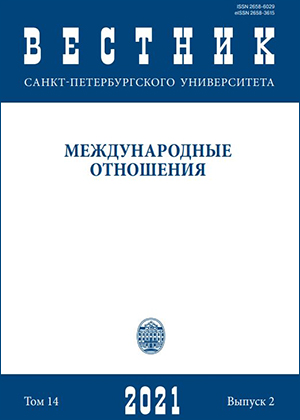Cooperation between China and Central and Eastern European states within the framework of the Belt and Road Initiative and the ‘17+1’ mechanism
DOI:
https://doi.org/10.21638/spbu06.2021.207Abstract
The Belt and Road initiative (BRI) is a large-scale geo-economic project which is an integral part of China’s contemporary foreign policy. The foundation of this project is the vast network of trade and transport communications by land and sea that encompasses countries of the Eurasian continent as well as Africa. The European destination is a key link of the project: most of the transit ways of the BRI lead to the EU and European countries. The Central and Eastern Europe region (CEE) occupies a special place in China’s strategy of the implementation of the Belt and Road initiative: the countries of this region are located on the main trade routes from China to the most developed European countries. Moreover, the CEE countries are in dire need of investment and infrastructure development. In 2012 China launched a multilateral cooperation mechanism with 16 CEE countries (in 2019 the number of participants increased to 17 due to the accession of Greece). This article aims at analyzing the structure and functioning of the mechanism, key areas of activity within the framework of the Belt and Road initiative, and the problems and prospects of cooperation between China and the CEE countries. The main hypothesis of the work is that China uses the ‘17 + 1’ mechanism as a tool for establishing bilateral cooperation with selected countries of the region. Such an approach evokes criticism from the CEE states, as well as EU institutions. The current situation shows that China needs to make adjustments to its strategy for the implementation of the BRI initiative in the region. The authors used legislation and materials from official websites of EU institutions, China and the CEE countries’ government agencies, statistical data and analytical papers by international organizations, as well as material from news agencies.
Keywords:
China, Belt and road, 17 1 mechanism, integrational projects, Central and Eastern European countries
Downloads
References
GDP growth (annual %) (2020), World bank. Available at: https://data.worldbank.org/indicator/NY.GDP.MKTP.KD.ZG (accessed: 01.02.2021).
CEE Must Improve Infrastructure and Logistics (2017), Emerging-europe.com. Available at: https://emerging-europe.com/news/cee-must-improve-infrastructure-logistics/ (accessed: 01.02.2021).
Li Keqiang Meets with Prime Minister Nikola Gruevski of Macedonia release (2014), Ministry of Foreign Affairs of the People’s Republic of China. Available at: https://www.fmprc.gov.cn/mfa_eng/topics_665678/lkqzlcf/t1220937.shtml (accessed: 01.02.2021).
Development of international trade in goods, EU-27 (2020), Eurostat. Available at: https://ec.europa.eu/eurostat/web/international-trade-in-goods/data/database (accessed: 01.02.2021).
China’s Twelve Measures for Promoting Friendly Cooperation with Central and Eastern European Countries, 2015. Available at: http://www.china-ceec.org/eng/ldrhw_1/2012hs/hdxw/t1410546.htm (accessed: 01.02.2021).
The Suzhou Guidelines for Cooperation between China and Central and Eastern European Countries, 2016. Available at: http://www.china-ceec.org/eng/ldrhw_1/sz2015/hdxw/t1411473.htm (accessed: 01.02.2021).
Riga Declaration (2016), Yidaiyilu.gov.cn. Available at: https://eng.yidaiyilu.gov.cn/zchj/sbwj/2331.htm (accessed: 01.02.2021).
The Dubrovnik Guidelines for Cooperation between China and Central and Eastern European Countries, 2019. Available at: https://www.ceec-china-croatia.org/files/dubrovnik-guidelines.pdf (accessed: 01.02.2021).
China pledges to boost trade and infrastructure ties with CEE countries (2019), Intellinews. Available at: https://www.intellinews.com/china-pledges-to-boost-trade-and-infrastructure-ties-with-cee-countries-159626/ (accessed: 01.02.2021).
China, CEEC banks to further strengthen 16+1 cooperation, 2018. Available at: http://www.china-ceec.org/eng/zdogjhz_1/t1575550.htm (accessed: 01.02.2021).
Richet, X. (2018), The 16+1 Format: Chinese presence in fragmented markets on the periphery of Europe. China-CEE Institute. Available at: https://china-cee.eu/wp-content/uploads/2018/07/Xavier-Richet.pdf
final CEE countries align with Belt, Road Initiative (2017), China Daily. Available at: https://www.chinadaily.com.cn/world/cn_eu/2017-11/29/content_35117825.htm (accessed: 01.02.2021).
The motorway that China couldn’t build (2011), Vox Europe. Available at: https://voxeurop.eu/en/content/article/716731-motorway-china-couldnt-build (accessed: 01.02.2021).
Tuzla 7 lignite power plant, Bosnia and Herzegovina Initiative (2018), Bankwatch Network. Available at: https://bankwatch.org/project/tuzla-7-lignite-power-plant-bosnia-and-herzegovina-2 (accessed: 01.02.2021).
Serbia to sign $1bn infrastructure loan with China (2019), FDI Intelligence. Available at: https://www.fdiintelligence.com/article/74733 (accessed: 01.02.2021).
China-EU trade, European commission, 2020. Available at: http://ec.europa.eu/trade/policy/countries-and-regions/countries/china/ (accessed: 01.02.2021).
China says it respects EU laws and standards as 16+1 becomes 17+1 with new member Greece (2019), South China Morning Post. Available at: https://www.scmp.com/news/china/diplomacy/article/3005983/china-says-it-respects-eu-laws-and-standards-161-becomes-171 (accessed: 01.02.2021).
EU’s statement on South China Sea reflects divisions (2016), Reuters. Available at: https://www.reuters.com/article/southchinasea-ruling-eu-idUSL8N1A130Y (accessed: 01.02.2021).
Chinese Investment in Europe: a country-level approach (2017), ed. by J. Seaman, European Think-tank Network on China (ETNC). Available at: https://www.ifri.org/sites/default/files/atoms/files/etnc_reports_2017_final_20dec2017.pdf (accessed: 01.02.2021).
Europe and China’s New Silk Roads (2016), ed. by F.-P.van der Putten, European Think-tank Network on China (ETNC). Available at: https://www.ifri.org/sites/default/files/atoms/files/etnc_2016-europe_and_chinas_new_silk_roads.pdf (accessed: 01.02.2021).
Belt and Road Joint Construction Initiative progress, contributions and prospects (2019), Yidaiyilu.gov.cn. Available at: https://rus.yidaiyilu.gov.cn/document/issue/87094.htm (accessed: 01.02.2021). (In Russian)
China signs currency swap agreement with Hungary (2013), China-daily. Available at: http://www.chinadaily.com.cn/business/2013-09/10/content_16958489.htm (accessed: 01.02.2021).
Overview of China’s tourism industry. Embassy of Hungary Beijing, 2017. Available at: https://peking.mfa.gov.hu/eng/page/magyar-kinai-turisztikai-kapcsolatok (accessed: 01.02.2021).
Members and Prospective Members of the Bank. Asian Infrastructure Investment Bank. Available at: https://www.aiib.org/en/about-aiib/governance/members-of-bank/index.html (accessed: 01.02.2021).
‘Belt and Road’ a promising platform for China-Europe cooperation (2016), China.org. Available at: http://www.china.org.cn/world/2016-04/26/content_38325244.htm (accessed: 01.02.2021).
Li Manchang (2016), [Serbia has reached] Highest number of agreements with China, other countries [within 16+1] are jealous, Politika.rs. Available at: http://www.politika.rs/scc/clanak/367192/Li-Mancang-Najvise-sporazuma-sa-Srbijom-drugi-ljubomorni (accessed: 01.02.2021).
China, Serbia stress sovereignty and territorial integrity (2016). People’s Daily. Available at: http://en.people.cn/n3/2016/0619/c90000-9074410.html (accessed: 01.02.2021).
China’s investment in influence: the future of 16+1 cooperation (2016), European Council on foreign relations. Available at: https://ecfr.eu/publication/chinas_investment_in_influence_the_future_of_161_cooperation7204/ (accessed: 01.02.2021).
Statistical release. Statistical Office of the Republic of Serbia, 2020. Available at: https://publikacije.stat.gov.rs/G2020/PdfE/G20201025.pdf (accessed: 01.02.2021).
Press statements following Russian-Chinese negotiations (2015), Website of the President of Russia. Available at: http://kremlin.ru/events/president/transcripts/49433 (accessed: 01.02.2021). (In Russian)
Serbia’s 5G deal with Washington: The art of muddling through. European Council on foreign relations, 2020. Available at: https://ecfr.eu/article/commentary_serbias_5g_deal_with_washington_the_art_of_muddling_through/ (accessed: 01.02.2021).
Downloads
Published
How to Cite
Issue
Section
License
Articles of "Vestnik of Saint Petersburg University. International relations" are open access distributed under the terms of the License Agreement with Saint Petersburg State University, which permits to the authors unrestricted distribution and self-archiving free of charge.




